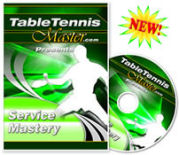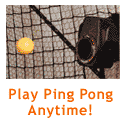What’s the single most important stroke, the one you much practice the most, put the most energy and time into and is going to win you the most games? Some will say the forehand loop, some the backhand chop, but to maximize you winning potential, these are both wrong. The one stroke you should practice most is the serve, YES the serve!
You can practice every other stroke in the book till the cows come home, but in a game you may never get the opportunity to play them, because you opponent control the game too well, or you are unable to set up the ball to play that stoke. Serves you are guaranteed to be able to play, and not just a few, but half the points in a match!
I’ve pointed this out to many players, and all agree that it’s important, but for the majority the real importance simply does not sink in. For the few that do ‘get it’ and practice serves on a regular basis, their game shows immediate improvements, and often results in them advancing a grade!
On serves you have complete control over all of these factors:
- type of spin
- amount of spin
- speed of the ball
- placement of the ball to any location on the table
You must use this control to your advantage! Use it to either win points outright, to setup a third ball attack, or even to intimidate your opponents with your huge arsenal of variations!
Although the serve of many top players may seem to like a simple and effortless motion, there is a lot of effort going into them, but it does not show since they have become so efficient at it and disguise it so well.
You should put a lot of energy into most serves if you want them to be effective and win you points. Sometimes this energy will go into speed, sometimes into heavy spin, and sometimes it does not go into the ball at all, but into a fake motion to make it appear like you’re putting a lot of speed or spin into the ball, but the energy should almost always be there!
So if you’re putting so much energy into the ball, how do you make sure it does not bounce off the end of the table? Well the key is for short serves to put this energy into spin instead. You can do this by hitting varying the spot where you contact the ball. For example for a fast swinging pendulum serve, if you hit the back of the ball, you’ll get a lot of speed, but if you contact the side of the ball, you can make the ball bounce very short and slow, but with a huge amounts of spin. Try it and you’ll see what I mean!
Mix this up with contact points a little more towards the top or bottom of the ball, and serve this in a range of locations, and you have a wide variety of serves with variations in spin, speed and location, all from a single swing with only subtle visible changes.
The key point in practicing these serves is NOT to get as much spin as possible (although this can already win you many cheap point in lower grades), but to focus on variation and disguising the type of serves that you’re playing.
I’ll leave further tips on serves for the next article because it’s a huge subject, but I can guarantee if you do practice your serves regularly, it will improve your game. The real good thing is that you don’t even need a partner to do it… all you need is a box of balls and access to a table. So give it go, you will not be disappointed!
Source: OOAK Table tennis articles


